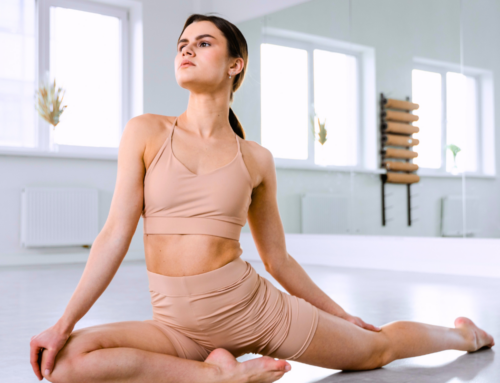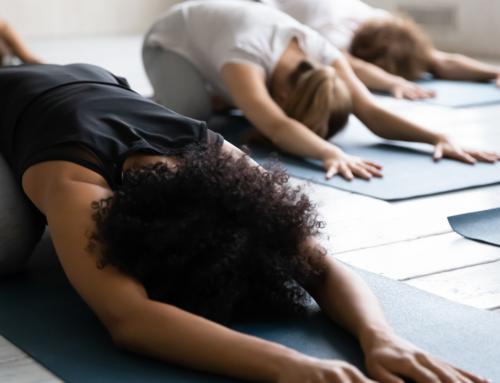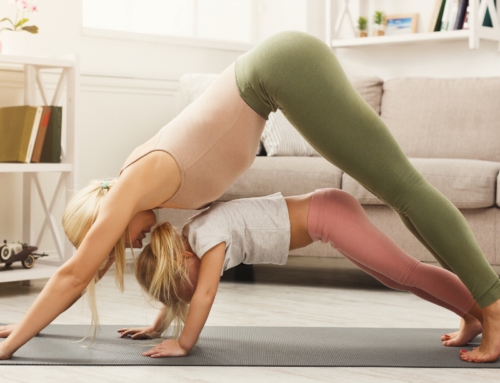Starting your mornings with a healthy and invigorating yoga routine can set the tone for a productive and balanced day ahead. Incorporating yoga into your morning ritual can provide numerous benefits, including increased flexibility, improved focus, and a sense of inner calm.
Below, we explore five yoga stretches, including heart openers and energizing poses, that you can add to your mornings:
Mountain Pose
Begin your morning yoga routine by grounding yourself in Mountain Pose (Tadasana). Mountain Pose helps improve posture, balance, and body awareness while promoting a sense of stability.

To practice Mountain Pose (Tadasana) with proper alignment and awareness, follow these cues:
- Begin by standing tall with your feet together or hip-width apart, whichever feels more comfortable. Distribute your weight evenly between both feet.
- Engage your leg muscles by lifting your kneecaps slightly and firming your thighs.
- Lengthen your tailbone toward the floor, creating a neutral pelvis position. Avoid arching your lower back or tucking your tailbone too much.
- Lift your torso upward, maintaining a long spine. Imagine a string pulling you from the crown of your head towards the ceiling.
- Relax your shoulders and roll them back and down, allowing your chest to open. Feel the space and freedom in your upper body.
- Extend your arms alongside your body, with your palms facing inward. Alternatively, you can bring your palms together at your heart center (Anjali Mudra).
- Soften your facial muscles and align your head directly over your shoulders. Gaze forward, keeping your chin parallel to the ground.
- Breathe deeply and evenly, allowing your breath to flow smoothly.
- Ground through the four corners of your feet—big toe mound, little toe mound, inner heel, and outer heel. Feel a sense of stability and connection with the earth.
- Maintain a sense of balance, finding a steady and rooted posture. Imagine yourself as a mountain, strong and unwavering.
- Stay in this pose for several breaths, focusing on your alignment, breath, and the sensations in your body.
- To release the pose, slowly lower your arms to your sides and come back to a relaxed standing position.
Cat-Cow Pose
Move into Cat-Cow Pose (Marjaryasana-Bitilasana) to awaken and warm up your spine. This dynamic flow gently stretches and mobilizes the spine while also engaging the core muscles.

To practice Cat-Cow Pose (Marjaryasana-Bitilasana) effectively, follow these cues:
- Start on your hands and knees in a tabletop position, with your wrists directly under your shoulders and your knees hip-width apart. Align your knees directly under your hips.
- Find a neutral spine by ensuring that your back is flat and parallel to the ground.
- Begin with Cow Pose:
- Inhale deeply, gently drop your belly towards the mat, and lift your sitting bones and chest upward. Allow your belly to sink towards the ground, creating a gentle arch in your back.
- Lift your gaze towards the ceiling, but be mindful not to strain your neck. Keep your neck in line with your spine.
- Extend your heart forward and broaden your shoulder blades, feeling a gentle opening in your chest.
- Transition to Cat Pose:
- As you exhale, round your spine towards the ceiling, starting from your tailbone. Draw your navel towards your spine and tuck your chin towards your chest.
- Allow your head to release down towards the floor, while feeling a stretch through your upper back and shoulders.
- Continue to round your spine, feeling a deepening curve through your back.
- Flow between Cat and Cow Poses:
- Inhale to transition back to Cow Pose, arching your back, lifting your sitting bones, and opening your chest.
- Exhale to transition to Cat Pose, rounding your spine and drawing your navel towards your spine.
- Coordinate the movements with your breath, using each inhalation and exhalation to guide the transition between the two poses.
- Repeat the flowing movement, alternating between Cow Pose and Cat Pose, for several rounds, synchronizing your breath with the movement.
- Maintain awareness of your body throughout the practice, focusing on the sensations in your spine and allowing it to move fluidly.
- After completing the desired number of rounds, come back to a neutral tabletop position and rest.
Downward Facing Dog
Transition into Downward Facing Dog (Adho Mukha Svanasana) to energize your entire body. Downward Facing Dog stretches the back of the legs, lengthens the spine, and releases tension in the shoulders, providing an overall sense of rejuvenation.

To practice Downward Facing Dog Pose (Adho Mukha Svanasana) correctly, follow these cues:
- Begin on your hands and knees, with your knees directly under your hips and your hands slightly forward of your shoulders. Spread your fingers wide and align them parallel to each other.
- Tuck your toes under and, on an exhale, lift your knees off the mat, straightening your legs. Your body will form an inverted V shape.
- Press your palms firmly into the mat, distributing the weight evenly between your hands.
- Engage your core muscles by drawing your navel towards your spine.
- Lengthen your spine by reaching your tailbone towards the ceiling and drawing your heels down towards the mat.
- Keep a slight bend in your knees to avoid hyperextension and allow for a more active stretch.
- Press through the base of your index finger and thumb to relieve pressure on your wrists.
- Relax your neck and let your head hang naturally, with your gaze directed towards your feet or between your thighs.
- Allow your shoulder blades to slide down your back and away from your ears, creating space and opening your chest.
- Press your heels towards the ground, but it’s okay if they don’t touch the mat. The focus is on lengthening the spine and creating a straight line from your hands to your hips.
- Continue to breathe deeply and consciously, taking slow, steady breaths in and out through your nose.
- Hold the pose for several breaths, gradually working towards longer durations as your practice progresses.
- To release the pose, gently bend your knees and lower them back to the mat, returning to a tabletop position.
Cobra Pose
Open up your heart and chest with Cobra Pose (Bhujangasana). Cobra Pose strengthens the back muscles, improves posture, and stimulates the digestive system, leaving you feeling energized and ready for the day.

To practice Cobra Pose (Bhujangasana) safely and effectively, here are the cues to follow:
- Begin by lying flat on your stomach with your legs extended and the tops of your feet pressing into the mat.
- Place your palms flat on the mat, directly under your shoulders, with your fingers pointing forward.
- Hug your elbows into your sides, keeping them close to your body.
- Engage your core muscles by drawing your navel towards your spine.
- On an inhalation, gently press your palms into the mat and begin to lift your chest off the floor. Keep your forearms and pelvis grounded.
- As you lift your chest, maintain a long and extended spine. Avoid straining your neck by keeping it aligned with the rest of your spine.
- Keep your shoulder blades drawn back and down, creating a broad and open chest.
- Focus on lengthening through the front of your body, rather than relying solely on strength to lift higher.
- Take care to avoid putting excessive pressure on your hands and wrists. Distribute the weight evenly through your hands and fingers.
- Allow your gaze to be gentle, looking forward or slightly upward, without straining your neck.
- Breathe deeply and hold the pose for several breaths, finding a balance between effort and ease.
- To release the pose, exhale slowly and lower your chest and forehead back down to the mat.
- Rest in a neutral position, turning your head to one side and gently rocking your hips from side to side.
Warrior II Pose
Finish your morning yoga routine with Warrior II Pose (Virabhadrasana II), a powerful posture that promotes strength and focus.

To perform Warrior Two Pose (Virabhadrasana II) correctly, follow these cues:
- Start in a standing position with your feet hip-width apart.
- Step your left foot back about 3 to 4 feet, keeping your toes pointing slightly outward.
- Turn your left foot at a 45-degree angle, so the heel aligns with the arch of your right foot.
- Keep your hips and torso facing forward.
- On an inhalation, raise both arms to shoulder height, parallel to the floor. Extend your arms out to the sides, with palms facing down.
- As you exhale, bend your right knee to a 90-degree angle, ensuring that your knee aligns directly over your ankle. Keep your thigh parallel to the floor.
- Press firmly through the outer edge of your left foot, engaging the muscles of your legs.
- Keep your torso upright and lengthen your spine. Imagine a vertical line extending from the crown of your head to your tailbone.
- Gently slide your shoulder blades down your back and away from your ears, creating space in your upper body.
- Turn your head to gaze over your right fingertips, keeping your neck aligned with your spine.
- Hold the pose for several deep breaths, maintaining a steady and relaxed posture.
- To release the pose, straighten your right leg, bring your arms down to your sides, and step your feet together.
- Repeat the same sequence on the opposite side, stepping your right foot back and bending your left knee.
–
Incorporating these five yoga stretches into your morning routine can have a transformative effect on your overall well-being. The heart openers and energizing poses help increase blood flow, release tension, and stimulate the body and mind. By starting your day with yoga, you cultivate a sense of mindfulness, balance, and gratitude, setting a positive tone for the rest of your day. So, roll out your mat, take a deep breath, and embrace the benefits of a morning yoga practice. Your body and mind will thank you!
Ready to practice with us at ONE Yoga’s studio or via livestream? Take a look at our schedule and membership options.




